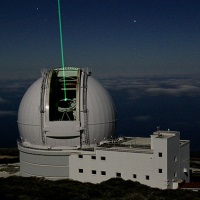The Isaac Newton Group of Telescopes: Astronomy in the Canary Islands

TTuesday 18th March, 2014
 |
Our speaker was Neil Parker who is Managing Director and co-founder of Green Witch Telescopes who have two shops — one near Cambridge and the other in Batley, West Yorkshire. The main focus of their business is telescopes and optical equipment and customers can rely on Neil's expertise as he used to be Deputy Director of the Royal Greenwich Observatory (RGO) and head of its Technology Division. He still carries out consultancy work on large telescope projects which will include advising observatories on which equipment to purchase.
In his time at the RGO he worked on a range of major telescopes including the Isaac Newton Group in the Canary Islands and the 8-metre Gemini Telescopes now operating on Hawaii and in Chile. So, it was no surprise that he was able to give us first-hand knowledge and show his own pictures in his talk "The Isaac Newton Group of Telescopes: Astronomy in the Canary Islands".
The Isaac Newton Group of Telescopes or ING sits roughly 2,400 metres above sea level atop the highest peak of the Caldera de Taburiente on the island of La Palma in the Canary Islands. They are part of the Roque de los Muchachos Observatory which, in turn, is part of the European Northern Observatory. The ING were formerly under the control of the Royal Greenwich Observatory before UK government cutbacks in 1998.
The Group consists of three large telescopes: the 4.2-metre William Herschel Telescope, the 2.5-metre Isaac Newton Telescope and the 1-metre Jacobus Kapteyn Telescope. The figures refer to the diameter of each telescopes primary mirror which usually need recoating every year to keep them in near-perfect condition.
However, dust collecting on each of the mirrors is not the only problem that each telescope installation has to put up with. The site lies next to caldera where fog collects and sometimes rises up enveloping the telescopes and halting observations. At other times the site's altitude means although it can be sunny down at sea level the actual peak can be covered in ice, snow and frost. Neil commented that on one occasion he had got out of his car in the observatory's car park and it was so icy he was being blown by the wind across the icy surface and only came to a halt due to coming up against a small perimeter fence.
At the other extreme there are wildfires in summer which can threaten the observatory that are ignited by lightning strikes or human carelessness. In 1997 a fire on the mountain damaged one of the neighbouring gamma-ray telescopes. The buildings and telescopes were luckier in subsequent fires in 2005 and 2009.
Some of the latest scientific results to come from the ING relate to data gathered using the William Herschel Telescope. Special optical interferometers were used to study how the density of stars varies throughout the disc of a spiral galaxy. Models propose that there are lines of enhanced star density that move through the disc of a galaxy in the form of a spiral. Scientists studied over a hundred nearby galaxies and found that there are more density waves than predicted.
This article was written for the club news column of the Stratford Herald. The actual lecture explained the subject at a deeper level.
